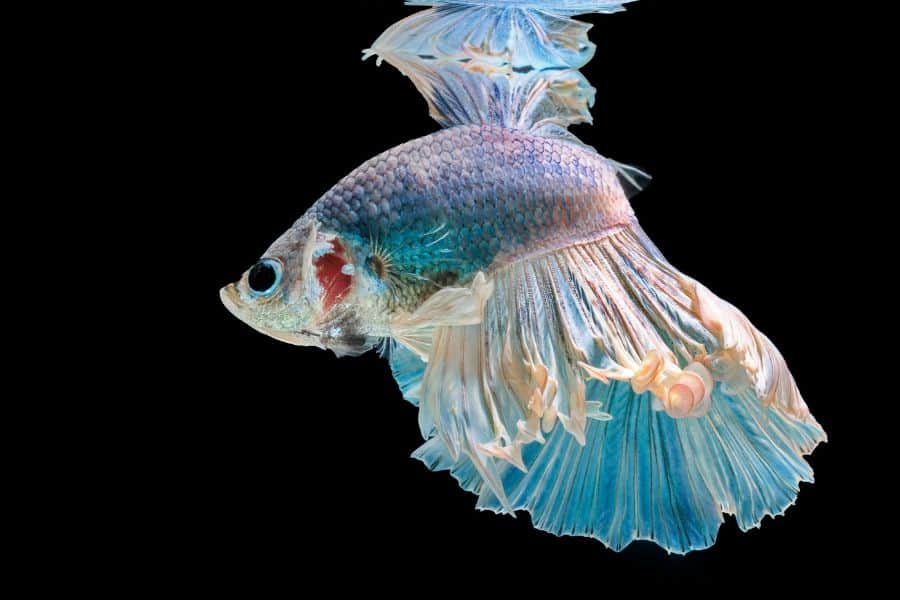Betta fish, with their vibrant colors and flowing fins, have captured the hearts of many fishkeepers, especially those new to the hobby.
But as resilient as these stunning creatures may seem, they are not immune to various diseases that can affect their health and well-being.
For beginner fishkeepers, it’s essential to recognize the signs of illness early on and take appropriate action to ensure the longevity and happiness of your aquatic companions.
In this article, we will discuss the most common betta fish diseases, their symptoms, and the preventative measures and treatments that can help you maintain a healthy environment for your beloved bettas.
14 Common Betta Diseases and Treatments
Here are some of the most common diseases that betta fish can suffer from. Make sure you watch out for these symptoms!
1. Fin Rot
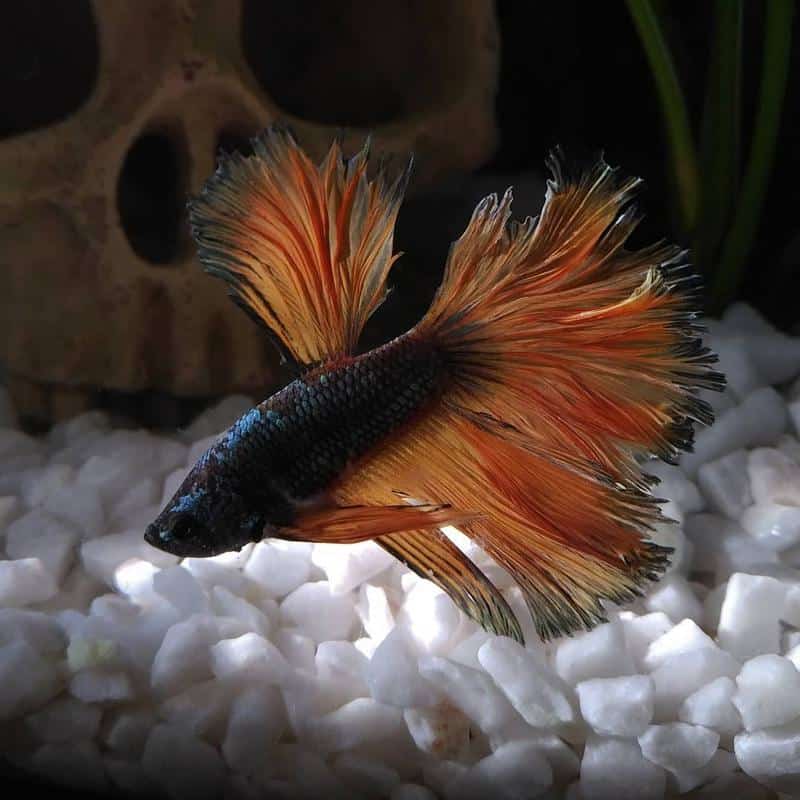
As the name implies, fin rot is a bacterial infection that causes a Betta’s fins to look like they’re rotting.
This type of disease starts at the edge of the fins, including the caudal (tail) fin, dorsal (back) fin, and pectoral (side) fins. When it occurs on the Betta’s beautiful tail fin, it’s often called tail rot.
Fin rot is typically caused by extreme stress, a dirty environment, or both. As the Betta’s immune system goes down, it becomes more prone to bacteria like Pseudomonas that cause the fins to rot, and even opportunistic fungal infections that can further worsen the problem.
Luckily, the damage caused by fin rot can still be treated and reversed. However, as it progresses, it will eventually consume the entire fin until it reaches the fin base. By that point, it becomes impossible for the Betta to regrow its fins. When left untreated, it will succumb to the disease.
Symptoms of Fin Rot in Betta Fish
- White edges on the fins
- Frayed fins
- Discolored fins
Fin Rot Treatment for Betta Fish
- Water change: The first thing you can do if you notice frayed fins on your Betta is to simply do a 50%-80% water change. Fin rot in its early stages can sometimes be treated with just clean water.
- Antibiotics: If it looks more serious, however, you’ll need to use antibiotics. Transfer your fish to a hospital tank and administer medications like API Super Ick Cure, Seachem MetroPlex (Metronidazole), or Tetracycline. API Fin & Body Cure should also work.
2. Ich (White Spot Disease)
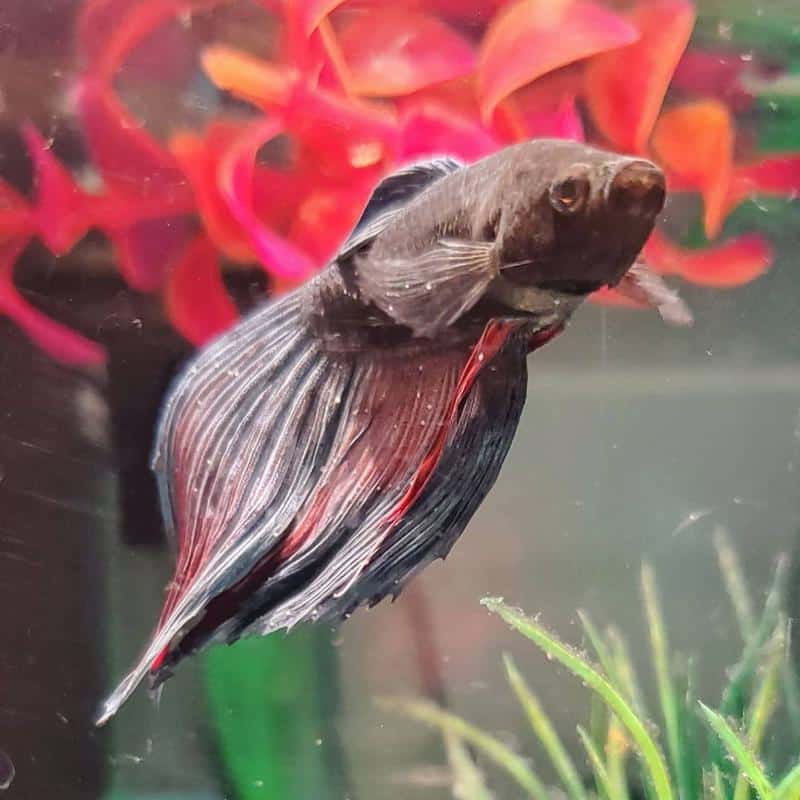
Ich, also known as Ick or “white spot disease,” is a parasitic disease caused by Ichthyophthirius multifiliis, a protozoan found in both freshwater and saltwater tanks. It’s the most common disease among pet fish, even Bettas.
The parasite that causes the disease lives on the Betta’s skin, inside the white spot-like spores that form on the Betta’s body. This is extremely itchy for the afflicted fish, which is you they tend to rub against objects or each other in the tank.
Interestingly, ich can’t be cured at all stages. Only when they’re free swimming–that is, extremely young–can medications kill them. Once the parasite has lodged itself onto your fish, the only thing you can do is to let it finish its life cycle while supporting your fish’s health at the same time.
Symptoms of Ich in Betta Fish
- White spots on the body, fins, and gills
- Frequent rubbing of the body against objects in the tank
- Lethargy
- Trouble breathing normally
Ich Treatment for Betta Fish
- Isolation: Since ich is extremely contagious, transferring your Betta to a hospital tank is best.
- Water change: Ich is a parasitic infection, and parasites love dirty water. Cleaning the water can help slow the spread of it and also prevent secondary infections like fungal diseases.
- Higher temperature: Raising the temperature of your tank to 85°F (29°C) for a week will help speed up the parasite’s life cycle, allowing it to be treated more quickly.
- UV sterilizers: Using a UV sterilizer can also help to break the cycle of infection and reduce the risk of further outbreaks.
- Medications: Over-the-counter medications like Malachite Green, Tetra Ick Guard, or Kordon Rid-Ich can be used to treat ich. Broad-spectrum medications like API General Cure also help.
3. Swim Bladder Disease
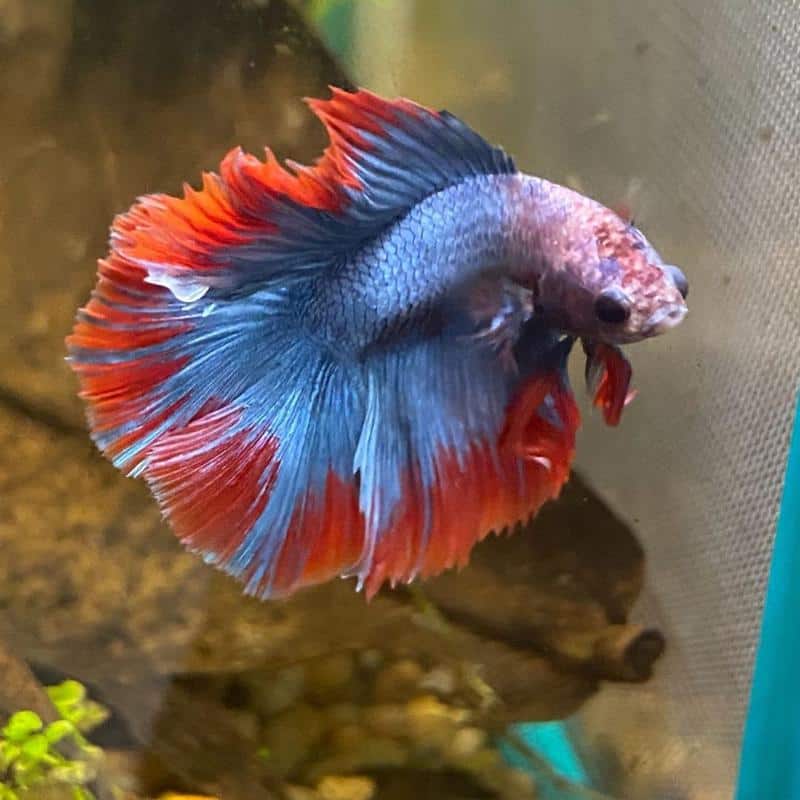
Swim bladder disease or swim bladder disorder is a condition that affects the Betta’s buoyancy.
All Bettas have a swim bladder, a sac in their gut filled with gas. This sac is what enables them to stay afloat in the water.
However, when a Betta fish becomes constipated or suffers from indigestion, it could lead to a swim bladder disorder. Typical culprits include the wrong type of food, poor food quality, or even an internal bacterial infection.
Sometimes, the Betta may also have a congenital problem regarding their swim bladder.
Symptoms of Swim Bladder Disease in Betta Fish
- Inability to swim normally
- Sinking to the bottom of the tank
- Swimming upside down
- Bloated stomach
- Reduced or lack of appetite
Swim Bladder Disease Treatment for Betta Fish
- Better food: The simplest solution to swim bladder disease is giving your Betta better food, such as Fluval Bug Bites or Aqueon Pellets. Higher-quality food have better ingredients. Additionally, opt for sinking or slow-sinking pellets, not flakes or floating pellets, so your Betta won’t have to go up to the surface and get more air than needed.
- Pea: Some aquarists claim that giving Bettas with swim bladder issues a single pea can help reduce their constipation.
- Fasting: You can also try fasting your Betta for a few days to give their digestion system a break.
- Antibiotics: A bacterial infection can also cause swim bladder disease, so you may want to use broad-spectrum antibiotics like Erythromycin or Tetracycline.
- Water change: A dirty environment can also lead to swim bladder disease. Some recommend daily water changes, but not all Bettas can handle stress, so you should exercise caution.
4. Dropsy
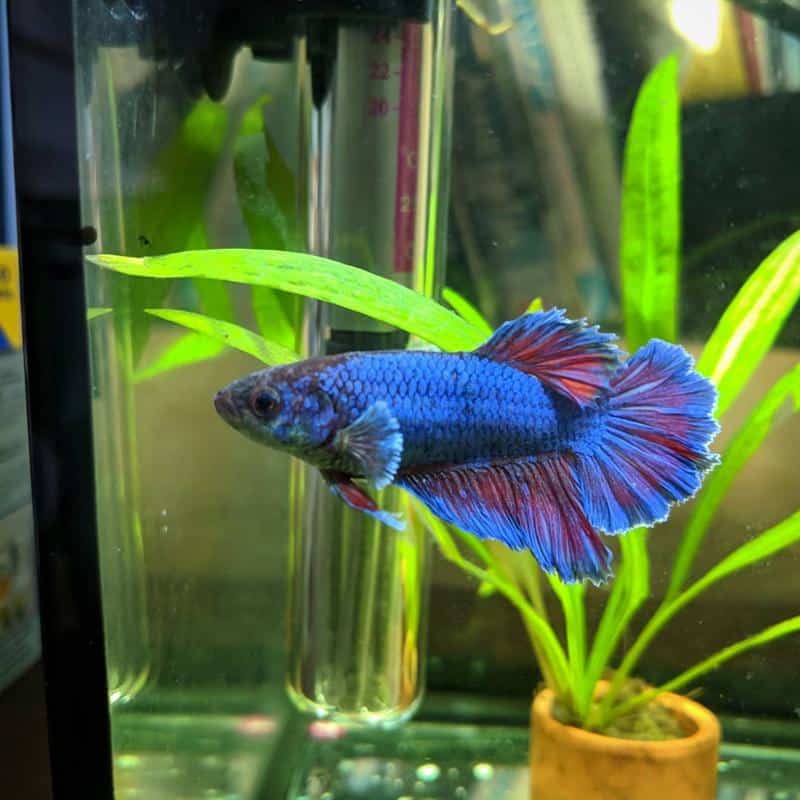
Dropsy is a serious condition that affects Betta fish. It’s also known as “pinecone disease” due to the fins of an affected Betta appearing to be a pinecone shape.
Dropsy isn’t a specific disease but rather a symptom of an underlying health issue. The swelling occurs due to fluid retention in the fish’s tissues and abdominal cavity, which could be caused by anything from bacteria to viruses to parasites.
Part of the problem with this common Betta fish disease is that it can be very difficult to determine the exact cause.
Remember that depending on what caused the dropsy, it may be impossible to treat. For instance, if the dropsy is caused by advanced organ failure, there’s nothing you can do to help your fish.
Symptoms of Dropsy in Betta Fish
- Swollen or distended abdomen
- Raised scales
- Loss of appetite
- Lethargy
- Clamped fins
- Pale coloration
Dropsy Treatment for Betta Fish
- Isolation: Since the exact causes of dropsy isn’t exactly known, moving the Betta to a separate quarantine tank is recommended to prevent the spread of any potential infection or infestation to other fish.
- Higher temperature: Bettas are naturally from warmer waters, so raising the temperature to 80-82°F (27-28°C) can boost their immune system and promote faster healing.
- Aquarium salt: Daily salt baths with API Aquarium Salt may help reduce swelling. Dissolve one teaspoon of salt per gallon of water in a separate container and place your Betta in it for around 15 minutes.
- Medications: Several medications, such as antibiotics or anti-parasitic drugs, may be used to treat potential underlying bacterial or parasitic infections.
5. Popeye
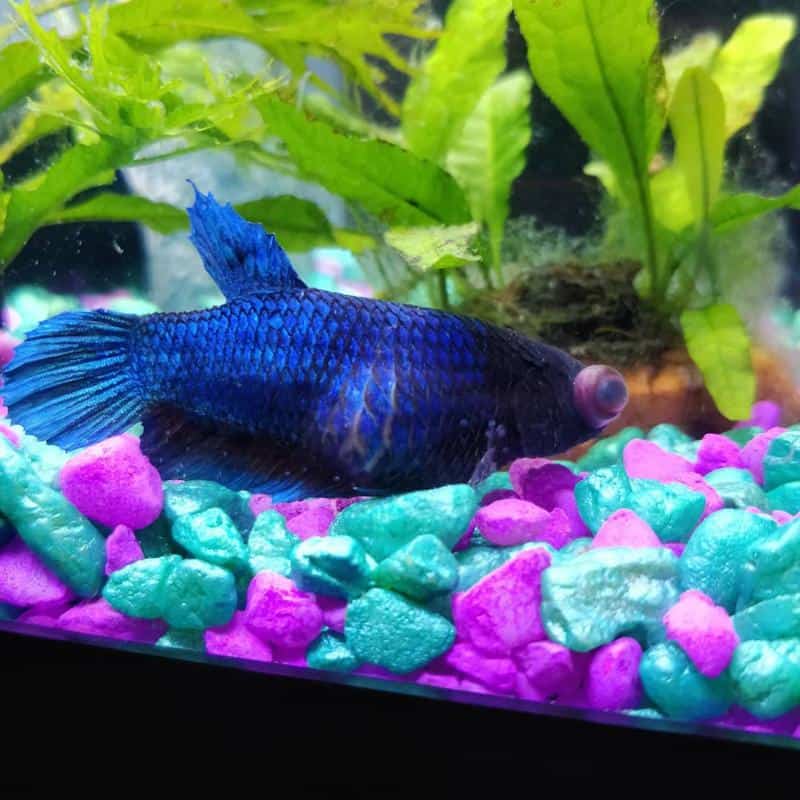
Popeye is a condition where one or both of the fish’s eyes become swollen or bulging. It’s called popeye because it causes the Betta’s eyes to appear larger than usual and even protrude from their eye sockets.
It’s typically caused by an infection, although physical trauma or a tumor can also be underlying causes. Unfortunately, if not caught in time, popeye can cause the eye to rot, leaving the Betta blinded in that eye.
Symptoms of Popeye in Betta Fish
- Swollen or bulging eyes
- Cloudy or discolored eyes
- Decreased or loss of vision
- Behavioral changes
- Disinterest in surroundings
Popeye Treatment for Betta Fish
- Isolation: If a bacterial or contagious infection causes the popeye, isolating the Betta helps prevent the spread of the infection to other fish in the tank.
- Medication: You can use an antibacterial medication to treat the underlying infection. Make sure you follow their recommended dosage and treatment duration.
6. Velvet Disease
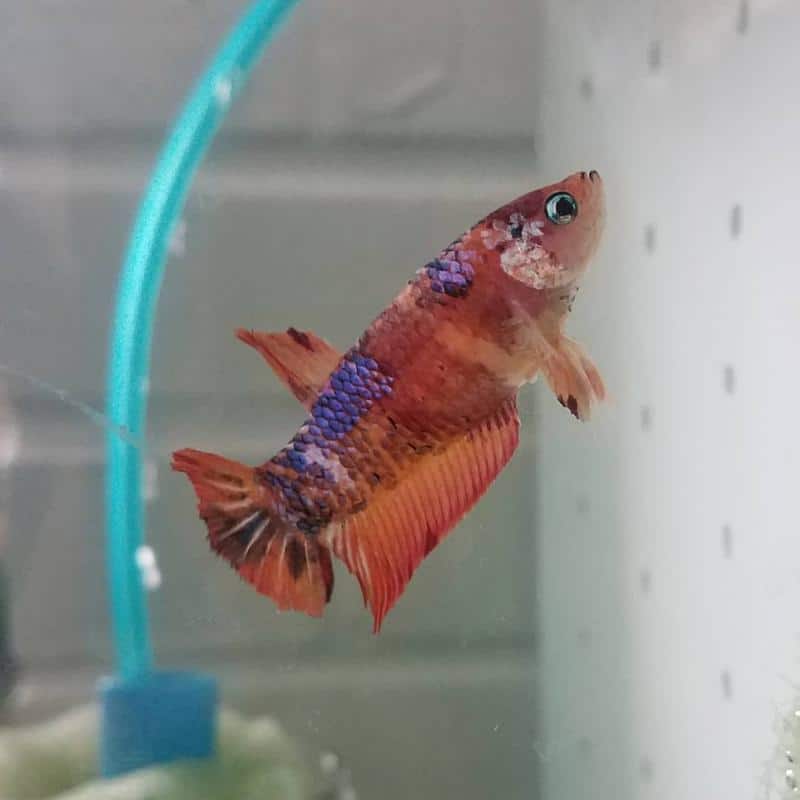
Velvet is a parasitic infection that can cause your betta’s body to become covered in golden-brown, rust-like dust. It also has a velvety texture, hence the name.
Velvet is one of the most frequent diseases in aquarium fish. The parasite that causes velvet is called Piscinoodinium pillulare. It’s a dinoflagellate, which is classified as a protozoan by some scientists and algae by others.
Healthy Bettas can usually recover from this infection, but those with weak immune systems or who are already stressed are more vulnerable to succumbing to this disease.
Sadly, it can kill all tank inhabitants before the unsuspecting owner even realizes what they’re up against.
Symptoms of Velvet Disease in Betta Fish
- Golden-brown coating
- Flashing and scratching
- Respiratory distress
- Lethargy and loss of appetite
- Pale or faded coloration
Velvet Disease Treatment for Betta Fish
- Isolation: The first thing you have to do if you notice velvet symptoms is to separate the infected Betta from other tank inhabitants. This disease is highly contagious, so you must act fast to minimize the risk of it spreading.
- Medications: Treating velvet involves adding anti-parasitic medication to your quarantine tank. The usual options include copper-based medication like Seachem Cupramine, Methylene Blue, or Malachite Green. Aquarium salt also helps.
- Higher temperature: One way to kill the parasites that cause velvet is by increasing the temperature to 85F (29C), which Bettas should be able to handle temporarily. This would make them uncomfortable if kept up for a longer period.
7. Columnaris
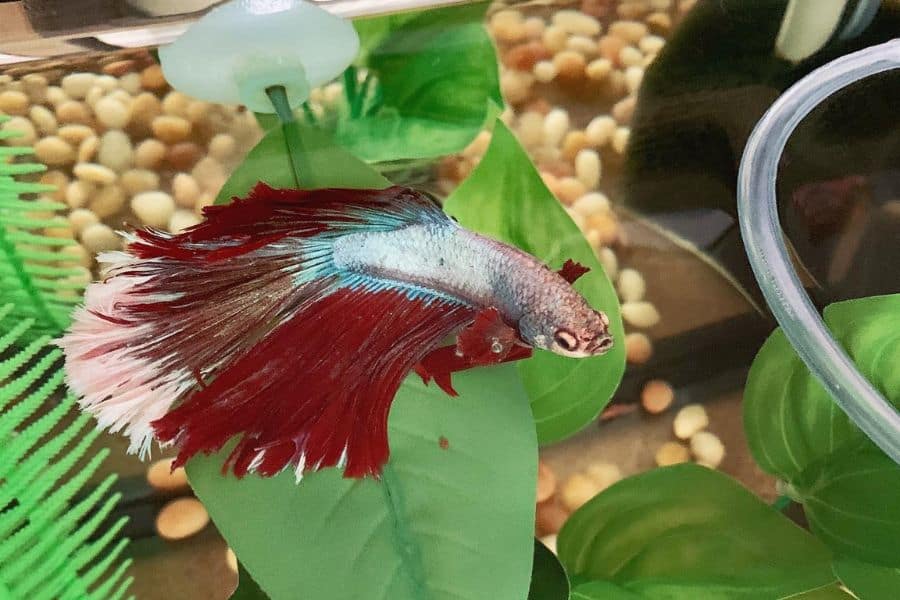
Columnaris, also known as cotton wool or cottonmouth disease, is a common infection found in freshwater fish.
Some aquarists mistake it for a fungal infection due to the cotton-like growths, but it’s actually caused by bacteria. In fact, the name comes from the shape of the bacteria that causes it, Flavobacterium columnare. Interestingly, this bacteria doesn’t attack saltwater fish.
Columnaris is highly contagious and can spread quickly in aquariums, so it’s important to act fast if you suspect that your Betta is affected.
Symptoms of Columnaris in Betta Fish
- Frayed fins that look similar to fin rot
- Skin ulcers or lesions
- White, cotton-like growths
- Reduction or loss in appetite
- Rubbing body against objects
- In advanced stages, brown gills
Columnaris Treatment for Betta Fish
- Isolation: As with any infectious disease, the first thing you should do is to separate your Betta from other tank inhabitants.
- Salt baths: Using API Aquarium Salt is a first line of defense against columnaris. Dissolve one teaspoon for each gallon of water in a separate container and place your Betta there for 15 minutes daily.
- Medications: Columnaris can be treated effectively with antibiotics such as Erythromycin and Tetracycline. Kanaplex and Furan 2 are also great over-the-counter options for columnaris.
- Water change: The bacteria that causes columnaris also thrive in dirty water. Making water changes can help reduce the amount of bacteria in the aquarium and prevent it from spreading.
- Lower temperature: Just like Betta fish, columnaris bacteria also love warm temperatures. The lowest temperature that Bettas can handle comfortably is 75F (24C), so reducing the temperature to this level can help reduce the growth rate of the bacteria.
Related: Why Is My Betta Fish Turning White
8. Gill Flukes
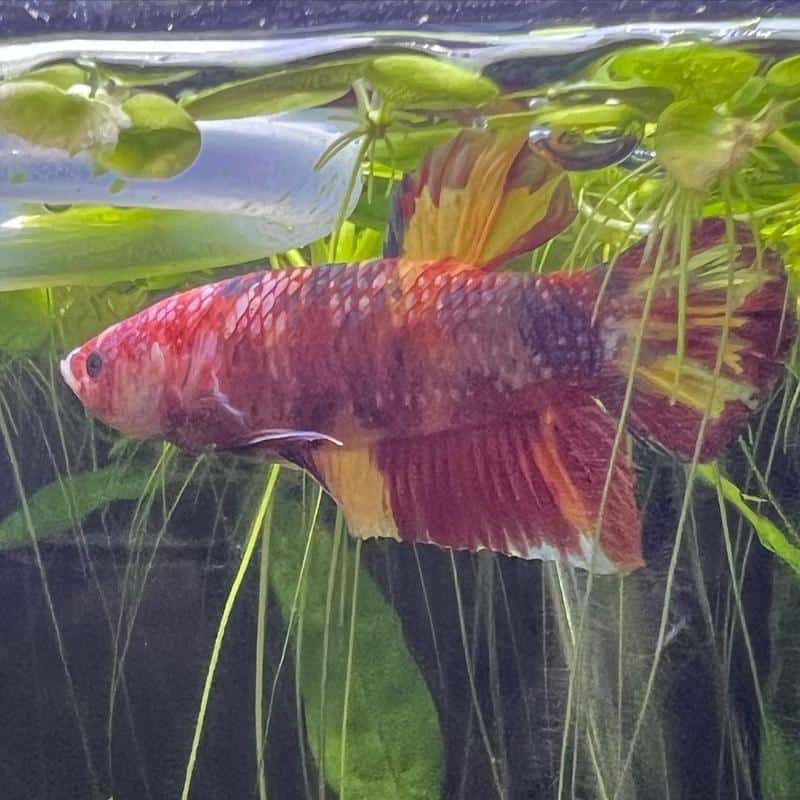
Gill flukes are parasites that commonly affect pet Bettas. They like making themselves comfortable inside the gills of a fish, occasionally their skin. However, they’re too tiny to actually see, so you’ll have to rely on the symptoms to confirm your suspicions.
While a small number of them may not pose much of a problem, too much can lead to a variety of problems. These parasites multiply very quickly and can cause serious damage, paving the way for secondary infections, like ulcers and respiratory diseases.
Symptoms of Gill Flukes in Betta Fish
- Gasping at the surface
- Labored breathing
- Mucus in gills
- Wounds on body and gills
- Rubbing against things
Gill Flukes Treatment for Betta Fish
- Isolation: As mentioned above, gill flukes are quick to multiply, which means they can easily spread inside the tank. Isolate your Betta the moment you see symptoms.
- Salt baths: In mild cases, salt baths can help reduce the number of parasites and any inflammation.
- Medications: For more severe cases, you’ll need to have an anti-parasitic medication on hand. Common medications for treating gill flukes in Bettas include Hikari PraziPro, formalin, and mebendazole. You can also use a broad-spectrum medication like API General Cure.
9. Anchor Worms
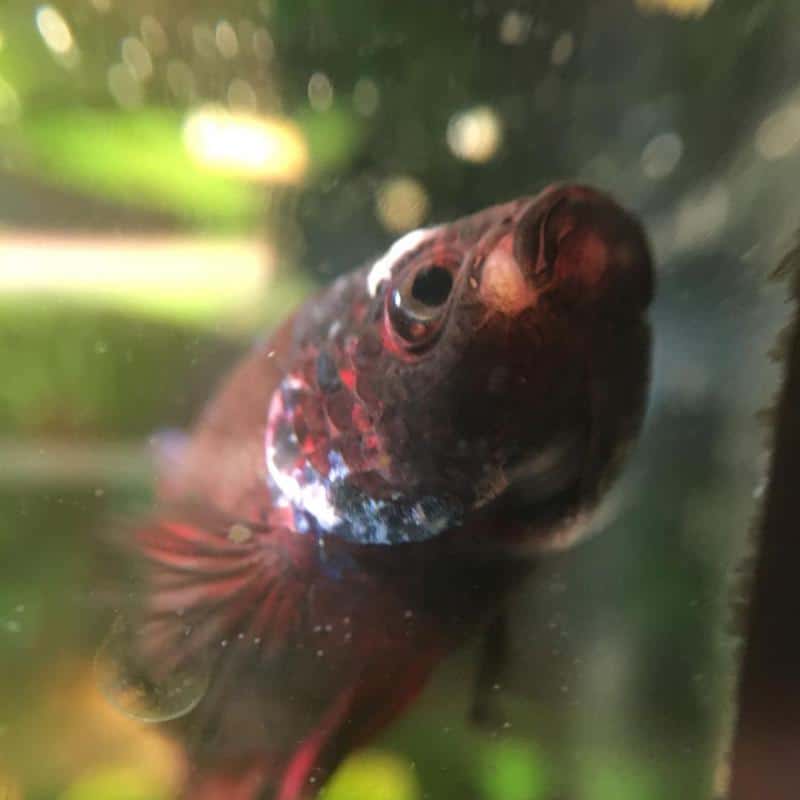
Anchor worms (Lernaea spp.) are parasites that attach themselves to the body of Bettas and other freshwater fish. Contrary to their name, they’re actually small crustaceans called copepods. They typically enter the aquarium via infected plants or even live food.
In bigger fish, they can be manually removed, but this can be difficult in a fish as small as a Betta. They can grow up to an inch long, feeding off of your Betta’s body. This causes discomfort, inflammation, and physical damages, as well as open wounds that can lead to secondary infections.
Symptoms of Anchor Worms in Betta Fish
- White or red bumps on the skin
- Irritation and inflammation on the affected site
- Ulceration or open wounds
- Scratching against the various objects
- Greenish or whitish threads poking out of skin
- Difficulty in breathing
Anchor Worms Treatment for Betta Fish
- Isolation: If you have other fish in the tank, you should move your Betta to a separate tank to prevent the spread.
- Water change: Anchor worms have a free-swimming stage in their life where they’re just floating in the water looking for a host. Making frequent water changes and vacuuming the substrate should help reduce their number.
- UV sterilizers: A UV sterilizer should help in killing free-swimming anchor worms.
- Medicated baths: One of the most effective and accessible ways to treat all stages of anchor worms is by dipping your Betta in a Potassium Permanganate bath or a formalin bath. Juvenile anchor worms will die, and you can scoop out the adults once they’ve detached themselves from your fish.
- Medications: Diflubenzuron and Trichlorphon are two other medications recommended for anchor worms, though we don’t recommend them for beginner aquarists.
10. Hole in The Head Disease
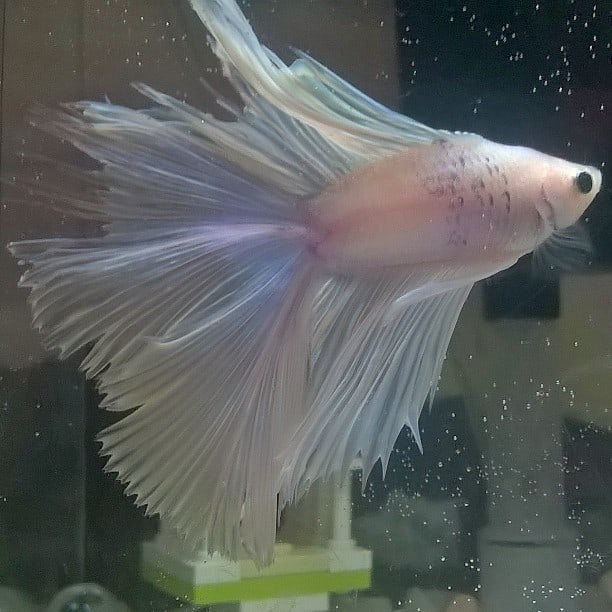
Hole in the Head disease, as its name implies, is a condition that causes holes, pits, and even erosions in a Betta’s head region. It can also affect the fish’s eye area and lateral region. Due to this, it’s officially known as “head and lateral line erosion (HLLE).”
The exact causes of HLLE aren’t fully understood as of this writing, but many factors can contribute to it, such as poor environment, bacterial infections, parasites, or inadequate nutrition.
Although it’s uncommon for hole-in-the-head disease to be fatal, it can lead to disfigurement and make life more challenging for your Betta fish. Also, the holes themselves can become prone to infection, potentially letting in bacteria or parasites.
Symptoms of Hole in The Head Disease in Betta Fish
- Small holes or pits in the head and eye area
- Lateral line erosion
- Lethargy
- Stress stripes on the body
Hole in the Head Treatment for Betta Fish
- Water changes: Increasing the frequency of your water changes can help keep the water clean.
- Broad-spectrum medication: Since HLLE can be caused by various factors, including parasites and bacteria, treating it with broad-spectrum medication like API General Cure is recommended.
- Proper nutrition: Make sure your Betta gets the best fish food available to you. You can also supplement your fish with vitamin C and calcium to further boost their immune system.
11. Hemorrhagic Septicemia
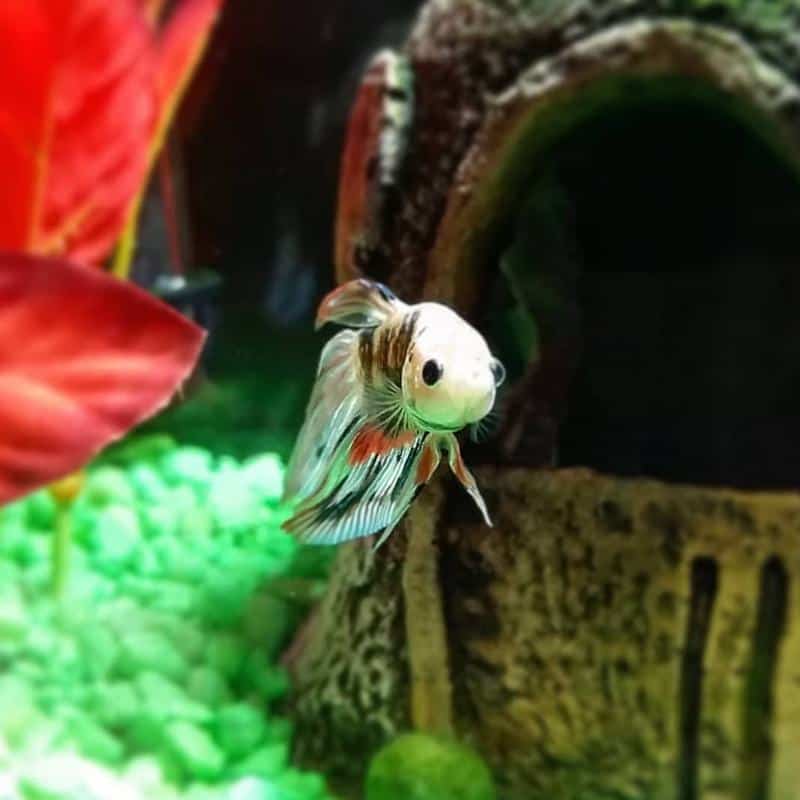
Hemorrhagic septicemia is a severe and potentially fatal bacterial infection in Bettas.
This disease gets its name from its two major symptoms: internal bleeding or hemorrhages and blood infection or septicemia. It’s the most common variety of septicemia associated with pet fish that live in home aquariums.
It comes from a pathogen called piscine novirhabdovirus, typically transmitted through the wastes of other infected fish, so if you’ve recently bought a new fish or even plants, it may be the cause of your Betta’s illness.
Symptoms of Hemorrhagic Septicemia in Betta Fish
- Reddish spots or streaks under the scales
- Open sores or wounds
- Discolored or pale patches
- Difficulty in breathing
- Clamped fins
- Reduced or no appetite
Hemorrhagic Septicemia Treatment for Betta Fish
- Isolation: As mentioned, hemorrhagic septicemia is highly contagious inside the tank. You should transfer your Betta to a separate, sterile tank for proper treatment.
- Medication: Antibiotics are your best bet for hemorrhagic septicemia. This includes over-the-counter medications like Kanamycin and Furan 2.
- Water change: Since this pathogen is excreted through waste, frequent water changes are necessary to remove traces of it from your tank. Make sure you’ve done a thorough change before taking your Betta back to the original tank.
12. Furunculosis
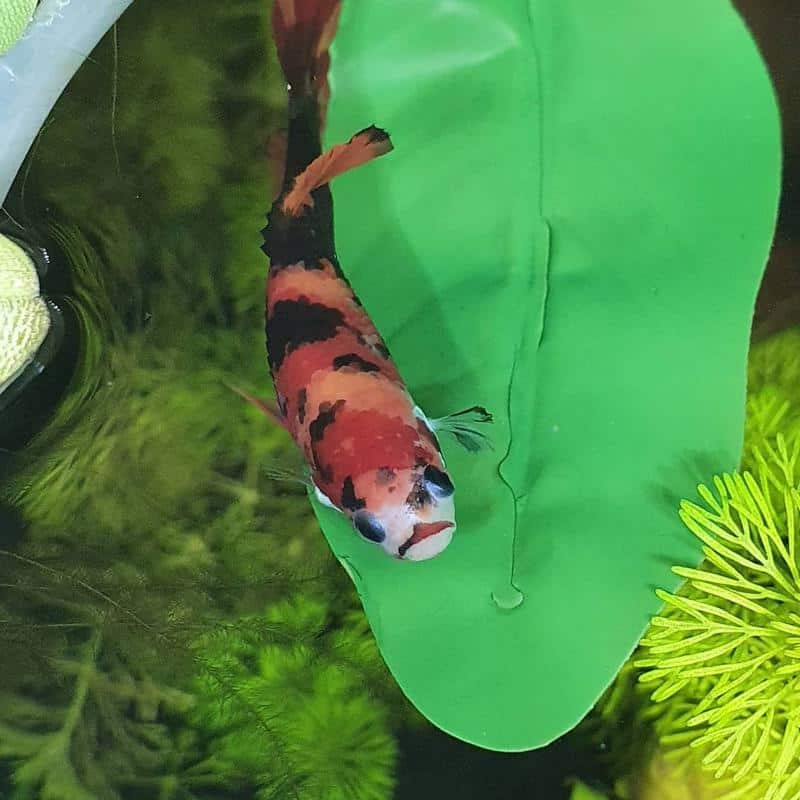
Furunculosis is a bacterial infection in Betta fish that’s characterized by ulcer-like sores or boils, where the disease gets its name. “Furuncle” means boil, and “-osis” means a condition or disease.
Furunculosis typically affects the head area of your Betta, but it can also spread to other parts of the body.
The pathogen that causes this disease, Aeromonas salmonicida, is known to be capable of wiping out entire populations of fish, so it’s best to take measures immediately if you’ve noticed any of its symptoms in your Betta.
Symptoms of Furunculosis in Betta Fish
- Boils on the skin
- Ulcer-like lesions or sores
- Reddish fins or tails
- Erratic swimming behavior
- Lethargy
Furunculosis Treatment for Betta Fish
- Medication: Furunculosis can be treated with medications like Terramycin, Chloramphenicol, and Sulfamerazine, but most of the effective options need a prescription from the vet.
- Isolation: Transferring your Betta to a separate tank can help stop the spread of the disease to other fish, as well as make treatment easier.
- Water change: As with other bacterial infections, Furunculosis can be spread throughout the aquarium, so it’s best to do a water change.
13. Tuberculosis
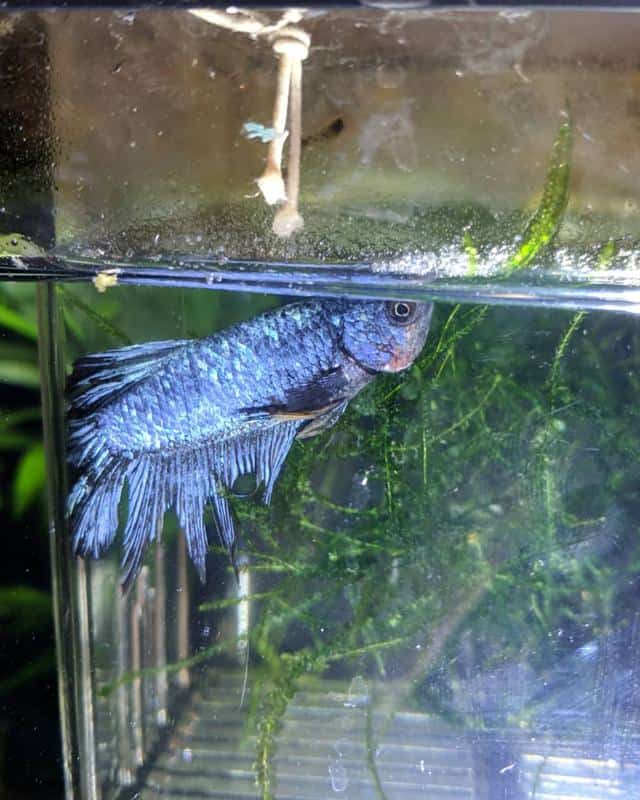
Tuberculosis in Betta fish isn’t as common as the other items on this list, but it’s still not rare enough to not be included in this article. It’s also a very sad Betta disease, as you’ll see your fish appearing to waste away as the disease progresses.
The bacteria that causes TB in fish is called Mycobacterium marinum, and it’s one of the very few fish diseases that can be transmitted to humans. Unfortunately, there’s no real cure for Betta TB. It can take months for the first symptoms to appear, and when that happens, there’s nothing you can do for your fish.
Symptoms of Tuberculosis in Betta Fish
- Curved spine
- Difficulty keeping oneself afloat
- Lethargy
- Pineconing
Preventing Tuberculosis in Betta Fish
Since TB isn’t treatable, prevention is the best cure. Here are some things you can do to avoid Betta TB, as well as most other diseases in this list.
- Choose your sources wisely: TB is spread mainly through new additions to your tank. When buying new live plants or fish, make sure you get them from reputable sources.
- Quarantine, quarantine, quarantine: Any new additions to your tank should be quarantined for at least 1-2 weeks. You can add Acriflavine or Methylene Blue to the quarantine tank to prevent any further infection.
- Keep up with water parameters: Regularly monitor your tank’s pH, nitrate, and ammonia levels with API Freshwater Masterkit to make sure that they stay within the ideal range.
- Follow good tank maintenance practices: Regular water changes and substrate vacuuming can help keep your Betta’s environment clean.
14. Tumor
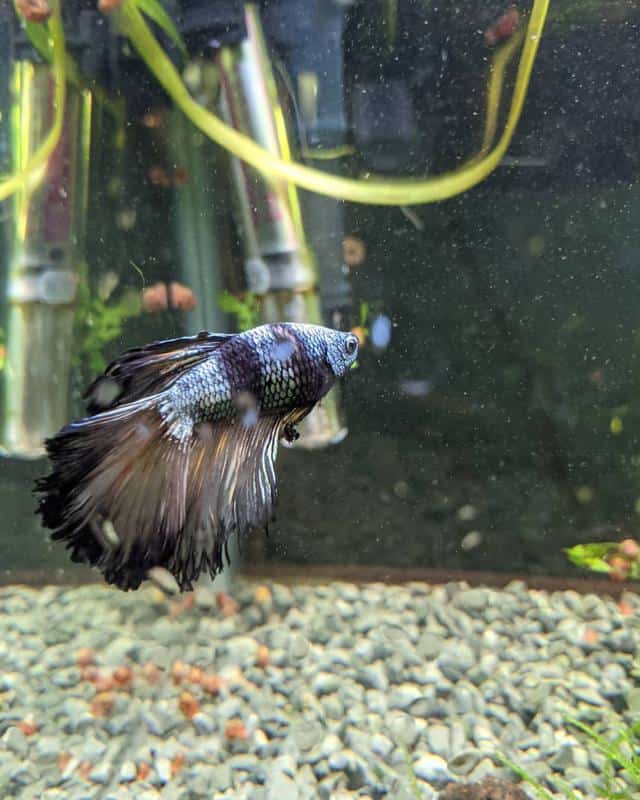
Betta tumors are growths that can develop anywhere in their body. They’re not necessarily cancerous — in fact, it’s actually rare for a Betta to have a cancerous tumor.
There’s no exact cause for them, but they’re believed to be a result of bad genes and environmental stressors. They’re a bit more common than TB, but thankfully still not as common as other curable diseases in this list.
The good news is that Bettas can still live pretty decent lives even with a tumor, as long as the tumor isn’t in a life-threatening spot. Their lifespan will be impacted, but they can still live out their days happily in a properly maintained tank.
Symptoms of Tumor in Betta Fish
- Visible growths on their body, fins, or gills
- Reduction in activity
- Difficulty in swimming if the tumor is on the fins
- Difficulty in breathing if the tumor is on the gills
Tumor Treatment for Betta Fish
The best way to treat Betta tumors is to remove them surgically. That said, it’s not rare for tumors to come back even after surgery.
We understand that not everyone has access to a fish specialist, so if that’s not an option for you, we suggest simply making your aquarium as comfortable as possible for your Betta.
Make sure there are no sharp decorations that can accidentally cut their lump, and add plenty of plants and hiding places to make them feel safer. You can still house them with invertebrates like snails or shrimp, but we don’t recommend putting them with other fish.
Also Read:
FAQs
How Often Should I Change Water for Sick Betta?
Normally, you can change the water at least once per week.
But although clean water is very important for a sick Betta fish, changing the water can cause their stress levels to go up, which isn’t good if their immune system is already compromised.
This is why it’s recommended that you transfer your Betta to a separate hospital tank that’s easier to keep clean with a siphon or small vacuum.
How Long Can a Sick Betta Go Without Eating?
Betta fish can go 10-14 days without eating, but it’s not recommended, especially when they’re sick.
Letting them go a few days without food is basically starving them, and it can worsen whatever symptoms they’re already experiencing.
What Is the Best Medicine for Sick Betta Fish?
The best medicine for sick Betta fish depends on what their sickness is. That said, there are some staples that are good to have on hand.
For instance, methylene blue, malachite green, and plain aquarium salt are broad-spectrum treatments that can solve a multitude of problems.
You can also keep antibiotic medications like Kanamycin, Ampicillin, Furan 2, or Maracin 1 and 2.
Does Salt Help Sick Betta Fish?
Aquarium salt helps sick Betta fish by improving their electrolyte balance and reducing stress. It also has antiseptic properties, which can help clear up certain types of infections.
However, too much can cause harmful effects on your fish. Also, salt can kill planted tanks, so keep that in mind if you have live plants.
Conclusions
Betta fish are beautiful creatures, but they are also prone to various diseases that can be fatal if not treated properly.
Understanding and addressing these diseases in Betta fish is essential for the well-being and longevity of these captivating animals. Make sure you maintain optimal water conditions, provide a nutritious diet, and be proactive in checking out possible symptoms.
With proper knowledge and attention, you can keep your beloved pet thriving and flourishing for many more years!
